

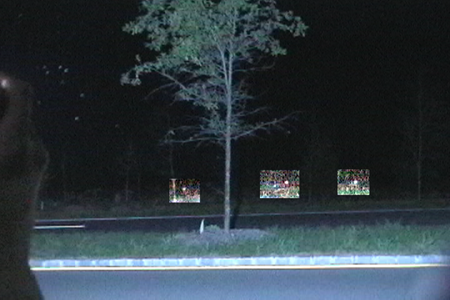
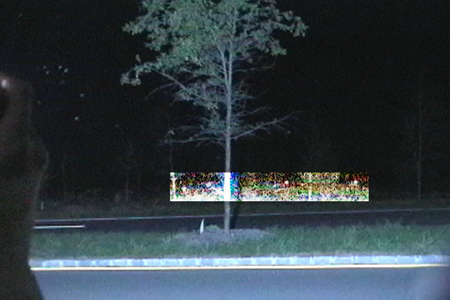
As mentioned in the original Coyote Sighting Account, I was driving home through Livingston campus late one evening when standing before me in the middle of the road was what I believed to be a wolf or a coyote. I stared the creature down before for several seconds before the headlights of another car scared it away. While many doubted what I had seen when I told the story the next day, Jessica was the only one who didn't laugh. This began an exchange of interesting stories about the stranger side of Rutgers, and thus, Rutgers Rarities was born. While there have been many confirmed reports of coyotes from friends, Piscataway Township workers, and facility maintenance workers at Rutgers, Jessica had never seen a coyote with her own eyes until recently. Her first sighting was near the Facilities Maintenance Building, as she saw a single coyote, small enough to possibly be a pup, running its normal hunting route. Witnesses from the Visual Arts Center and the Facilites Maintenance Building confirmed reports of individual coyotes running through their normal paths around that area.
While all of the previous reports were of single coyotes, the most exciting discovery was made several days later by Jessica, her second sighting within a week. As we drove down Avenue E on Livingston (just past the RAC) on our way to Busch Campus, Jessica yelled that she had just seen them (the coyotes). Unlike the previous reports, she had witnessed an entire pack of at least 10 or 12 that she said were of different colors and sizes. Pulling the car around, we were lucky enough to see several before they ran back into the woods. One coyote in particular stared back at us from across the street, and another, much larger one, made his presence known. It appeared to be the Alpha male, and was the last to inspect us before following the rest of the pack into the woods. Some footage was captured and the coyotes can be seen in some of the stills. A video was also captured of one of the coyotes running, and these can all be found in the Coyote Account Update. A drive back to home base had actually turned out to be an important investigation, and one that will be further explored. Let's just say there's a better than average chance that the next investigation of this nature will involve pork chops.
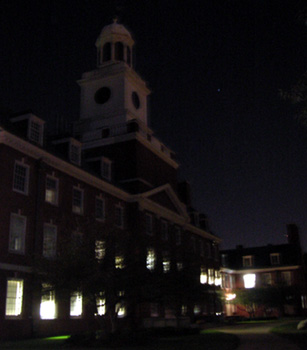
Our first investigation with guest investigators turned out to be quite a success after a nerve-racking start. Members of a New Jersey newspaper accompanied our first exploration of a location that was quoted as being one of the scariest places on campus by a facility maintenance worker. As in all investigations, there was no guarantee of success, so it was a fairly big risk to bring members of the press to a potential failure. The investigation started off rocky, as all of doors to the public building appeared to be locked up. It wasn't until the last possible entrance was checked that we gained access. After running into several roadblocks, roof access was finally achieved in a pitch black mechanical room with a spiral staircase. This led up to an illuminated room containing a busted ping pong table and piles of old journals and magazines. Another spiral staircase led to the balcony of the bell tower with a beautiful view of the campus. After ascending a metal ladder into the room behind the clock faces, a final ladder brought us to the pinnacle. Instead of finding a bell, however, the only thing that was found was a set of speakers. While listening carefully for any signs of phenomena, the speakers were set off and boomed in our unprepared ears. The sheer volume of the tones forced us to evacuate a bit prematurely. Reflecting on the experience, this was probably the most gut-wrenching part of the investigation. Rather than spooky and scary, as we were expecting from the tip we had received, the spot was rather tranquil and serene. It is possible that Waksman had spared us that night, but either way, it was a worthwhile investigation that has been turned into the No-Bell Account, named for both the award to Selman Waksman for his discovery of streptomycin, the cure for tuberculosis, and the lack of an actual ringing device in the tower.
Thanks to our contact "a", who has been a great resource for Rutgers Rarities, also
confirming the existence of the Unidentified
Livingston Creature, we were provided with information that led to the investigation
of Lucy Stone Hall. "a" wrote an e-mail about the phenomenon, stating:
While this is not particularly a weird experience, it may be something
worthy of interest or investigation. On Livingston Campus, at the juncture
at which the path coming from quads 2 & 3 meets the overpass of the B wing
of Lucy Stone Hall, one may often find bird carcasses. These are not small
birds that may have fallen from a nest or something, but larger adult
birds of different species lying dead with no apparent or grave physical
injuries. Just having come from there after reading the targum article
about your site, I noticed 4 bird corpses in varying stages of
decomposition at that spot. A possibility is that they accidently fly into
the windows, however, it would seem then that they would ricochet back
rather than landing under the overpass as they do, and that they would
probably be more obviously injured (not to mention that the windows would
show some sign of this constant barrage). Additionally, this wouldve been
notable in previous years; however to my memory this has not heretofore
been a regular occurence until the start of this year, during which I have
noticed as many as 5 rotting there until maintenance comes and disposes of
them. I would estimate that as many as 15-20 birds have died in that area
since the beginning of september. Is there some malicious maintenance
worker dishing out poisoned scraps to further his anti-aviation ideology?
Are birds choosing death over life among the depressingly cold
architecture of the livingston campus? Did Jesus do this? It might be an
interesting thing to speculate upon if you ever find yourself on
livingston with nothing to do.
Sure enough, when we went to the location, there were several dead adult birds that did
not appear to be the victims of flying into the overpass. They looked more like they had
been subject to taxidermy and belonged in a nature exhibit. If anyone has insight into
the reason for this strange occurrence, which apparently occurs regularly and should be
visible to many students on Livingston campus, please let us know.
Bird's the Word - Lucy Stone Hall Dead Birds
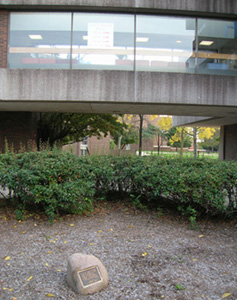
Behind the Livingston barracks, formerly a part of Camp Kilmer.
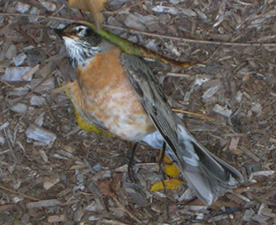
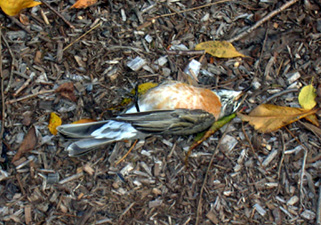
From the outside looking in to the strange abandoned
interior of the barracks.
Alongside River Road, across the street from Johnson Park, right on the Piscataway/Highland
Park border, there is a huge woodsy lot with an old iron fence that runs parallel to the
road below a steep incline. When driving by all you can see is the summit of the steep
hill of woods and the fence, nothing too obviously interesting to the casual commuter,
but to the ever-intrepid RR Team, where there's an iron-bound fence and woods- there's
something cool. Sure enough, when we decided to explore the area further and find out
exactly what the fence was meant to keep out (or in), the Team found yet another
interesting abandoned industrial site which
suggests that the Rutgers area is literally peppered with environmentally questionable
spots.
This one, technically located in the furthest eastern section of Highland Park, is vaguely
listed in town maps as the "former industrial site" and "filling station" adjacent to
Cleveland Ave and an active Conrail railroad line. All attempts via the Internet to find
out exactly what "industry" was originally located here have been fruitless. Clearly,
like Union Carbide, this was a site of some level of hazardous contamination as nearly
every trace of the former structure has been removed and there are these strange pipes
that go into the ground which are actually used to for testing toxicities in the soil. The
area is also listed with the New Jersey Department of Environmental Protection as one of
the Underground Storage Tank (UST) Contamination Sites, but the company that was there is
not named. After walking alongside the railroad track, the RR Team found an access point
where the barbed wire fence had ended. They found the site to be a desolate wasteland
that while mostly hidden by the woods alongside River Road, is an apparent and obvious
eyesore in the quaint Highland Park suburban setting.
In addition to some strange wooden debris, the Team also found a remnant of an animal"s
bone at the site. This nearly petrified fragment turned out to be part of the joint of a
large muscular mammal, most likely a deer or large dog, which is only unusual in that
this fragment was found alone and not with any other parts of the animal"s frame. The most
likely explanation is that a deer was probably struck by a train on the nearby railroad,
but why such a small piece was scattered in an abandoned area remains a mystery. There
were few signs of life at the site, no birds, rabbits or deer. This place is a silent
testament to the reckless days of EPA-free industrial environmental exploitation. One can
only wonder if this site is yet another Rutgers Rarities
X-factor that in some way contributes to the strangeness of the area.
Land of the Lost - Former Highland Park Industrial Site
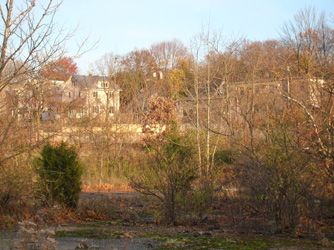

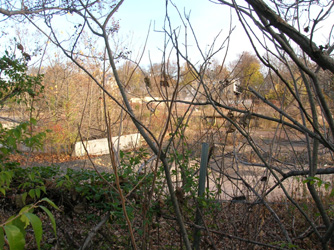
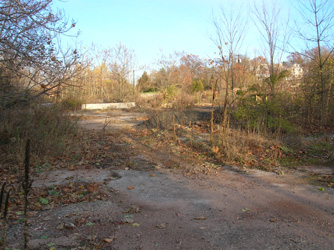
The desolate wasteland at the edge of Highland Park. Current
residents are neighbors to the abandoned factory.
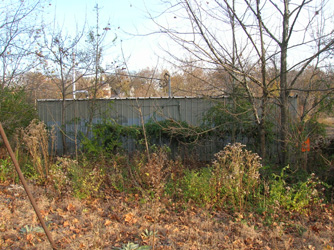
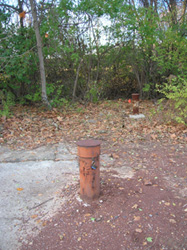
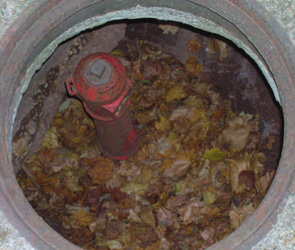
A trailer holding waste products and some of the tanks and testing sites which may have
previously contained (and my still hold) hazardous chemicals.

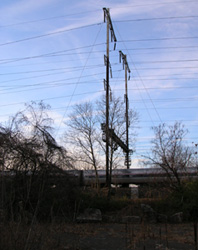
Train spotting alongside the tracks and from the former factory site.
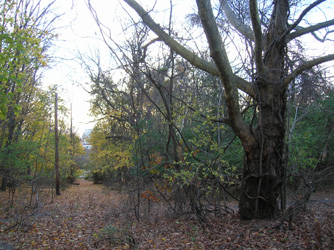
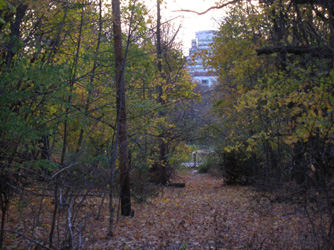
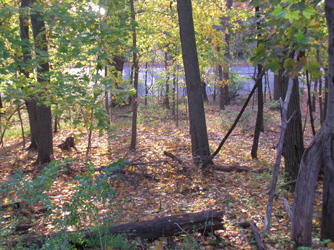
Shots down the hill toward River Road. For curious passersby the site is a mystery, as
it used to be for the RR team.
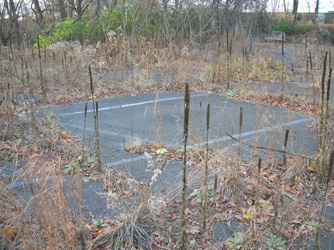
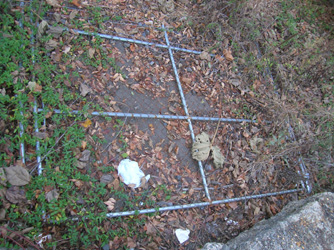
Evidence of a former parking lot. The iron gates on River Road used to provide an
entrance way and the path that led up the hill connected to the parking lot. A busted
fence on the train side did not stand the test of time.
When one member of the RR Team was contacted by an employee of "The Winery" in Bound Brook
regarding a spooky experience while working alone one day, the Team responded quickly, as
Bound Brook is an amazingly old creepy town that we have heard many strange tales about.
Rumors of hidden "speak-easys" from the days of Prohibition, stories of illegal immigrant
compounds and weird little graveyards abound in nearby Bound Brook, which is also home to
the unique "Rail" restaurant- a historical monument in and of itself.
Our contact met with us at the Winery and told us her
account of seeing inexplicable shadows and hearing
heavy, stomping footsteps on the mysterious second floor when there was absolutely no one
in the building but herself. According to our source, she was working alone in the
secured and alarmed building when she caught some shadows of movement under a door in
front of the stairway to the second floor. After seeing these unexplainable shadows, she
then heard a loud stomping and heavy treading on the second floor. She was 100% sure that
she was the only one there and she says it"s impossible for anyone to have gotten up to
the second floor without making any noises on the creaky staircases.
Our investigation of the old and eerily silent wine-making facility revealed nothing too
unusual but our source is 100% correct when she states that it would have been impossible
for anyone to get up to the huge loft on the second floor without revealing themselves.
The building is very old, the stairs are creaky and every noise made an echo in the huge
rooms.
The RR Team was impressed by the bravery of our informant as the Winery is a very cold
place, due to the storage of wines, and has a rather creepy appearance. We found an
interesting skull drawing inside one of the unfinished rooms on the upper floor and we
noted some unusual deviations in the structure of the building such as small partially
constructed rooms, unusually steep staircases, and a little balcony off the one side. The
place has sort of a mortuary-type feel to it and our source told us that she learned that
the second floor served as a sweatshop many years ago.
Upon inspection of the digital photos taken from the outside of the site after the
investigation was conducted showed evidence of several orbs, as shown in the pictures
below. There is one large one just above the second floor and two smaller ones. The RR
Team cannot help but wonder if there is a connection to the second floor pheomena reported
by our contact. In addition, the smaller orbs may possibly represent children who may have
worked at the sweatshop which was reported to exist at the site. Under the harsh
conditions of such a location the risk of injury or death may have been high. In any case,
it seems like more than a coincidence that the orbs are seen in the vicinity of the second
floor, the same location where stomping and loud noises were reported.
If anyone can confirm the history of the Winery or has any stories of their own about
buildings in Bound Brook please contact Rutgers Rarities
(rutgersrarities@rutgersrarities.com). Thanks again to K.A. who told us her
story and gave us a tour of this very cool place.
Fine Wine and Spirits - The Winery of Bound Brook
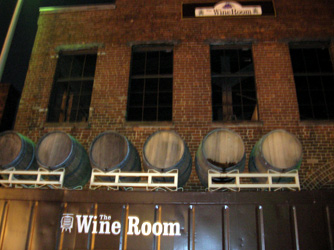
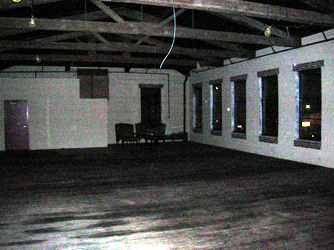
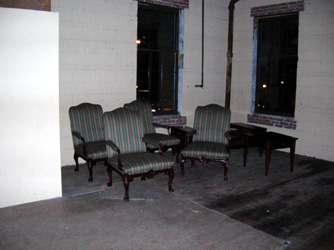
Second floor of the Winery with large open room and small
corner containing furniture.
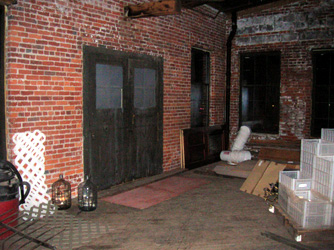
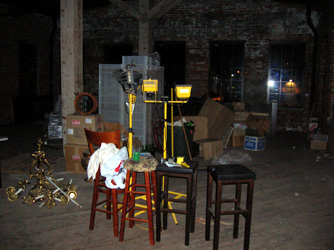
Crowded storage area of the second floor with entrance to the balcony and various lights,
bar stools, and boxes.
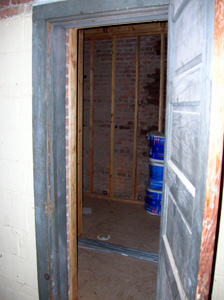

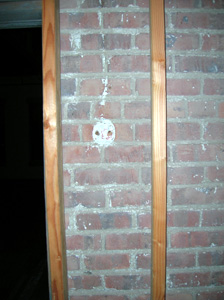
Mysterious unfinished room on the second floor in which the apparent drawing of a skull
was found.
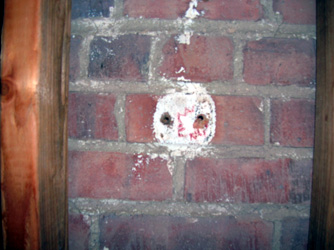

Close up image of skull inside unfinished room. View of the closed first floor door,
just as it was when the shadows were seen. Shortly after, the loud stomping was heard on
the second floor imaged above.
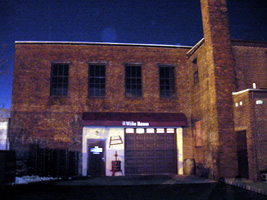
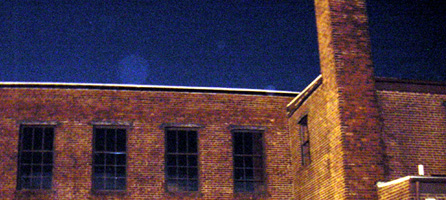
Photo taken outside the Winery after the investigation. Upon further inspection, a
large orb and two smaller ones were located above the area of the second floor. This may
be the result of spirits haunting the location, which would explain the phenomena. The
smaller orbs may also represent spirits of the children of the former sweatshop.
Okay, College Avenue Commuters, how many times have you passed the odd little tower on the
corner of George St. and Somerset St. on Old Queens? This tower is actually composed of
two circular rooms dedicated to the observations of the astronomical and mathematical
cycles of nature. This Observatory contains a refracting telescope and mean solar clock
that was modeled after the Tower of Winds of Athens in the year 1865. The 100+ year old
structure is named after Daniel S. Schanck who donated the funds that began construction
of the tower. Daniel, who was born in Middletown, NJ in 1812, was not a student of
astronomy, nor even a student of Rutgers. He moved to New York in his youth and became a
successful businessman who remained in the City for the rest of his life. Exactly why he
generously supported the construction of the phallic-like NJ Observatory is unknown. It
was rumored that he was very much in love with one of the wives of a Tutor at Rutgers and
built his monument to impress her. His lonely spirit is reputed to "haunt the tower" and
be visible on cold, starry nights when the planets are aligned just right.
For the RR Team, this is one of the most elusive mysteries on the College Avenue Campus.
After inspecting the building, we found it to be securely locked up, albeit with an old
rusty lock and according to the Rutgers index, the building has not been opened for more
than twenty years. Like the inaccessible Merriwood
Castle, the Schanck Observatory is an irresistible curiosity to the Team who would
love to learn its secrets.
Special thanks to Prof. William H. Bauer who leant the RR Team his copy of "Aloud to Alma
Mater", which has proved to be the most complete source of information on the Schanck
Observatory and other Rutgers historical spots.
Astronomical Observations - The Schanck Observatory

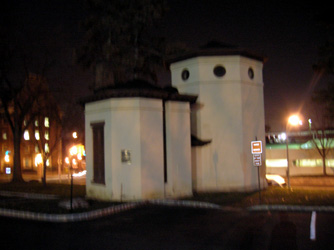
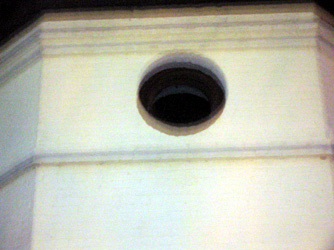
Rear view of the Schanck Observatory from the Kirkpatrick
Chapel parking lot. The secrets of what the observatory contains remain unknown.
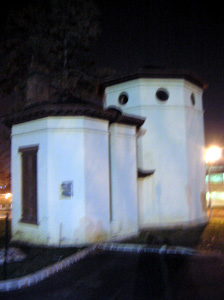
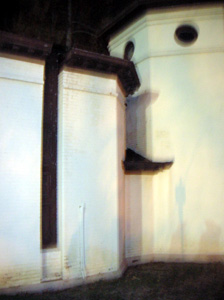
The observatory has been locked up for 20 years and is a major challege for the RR Team.